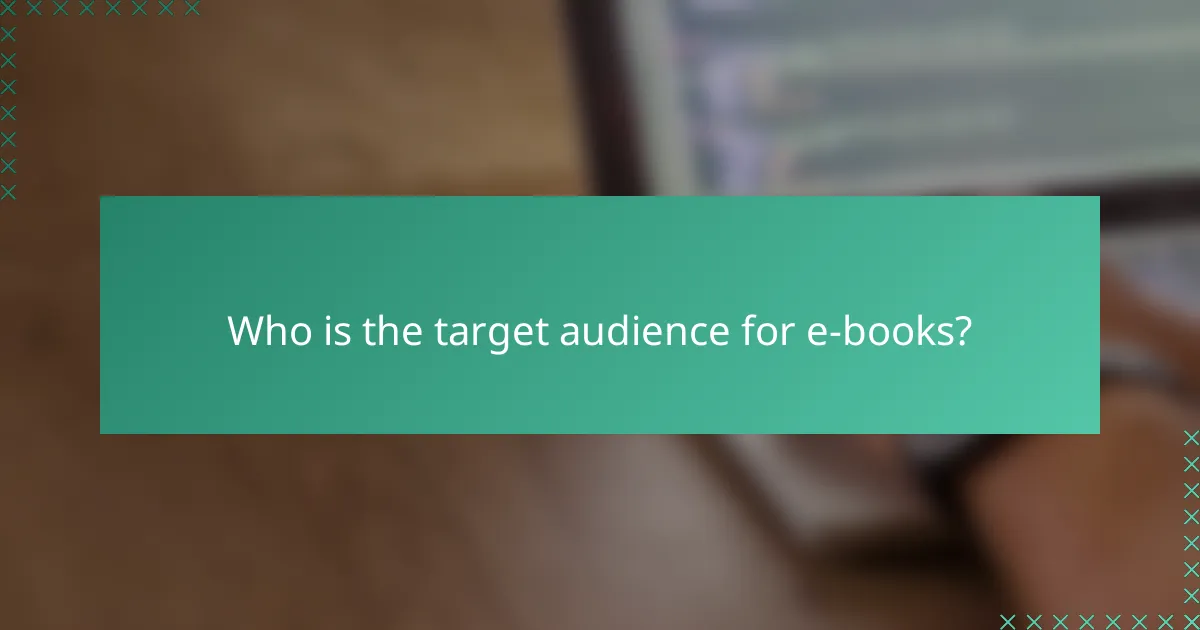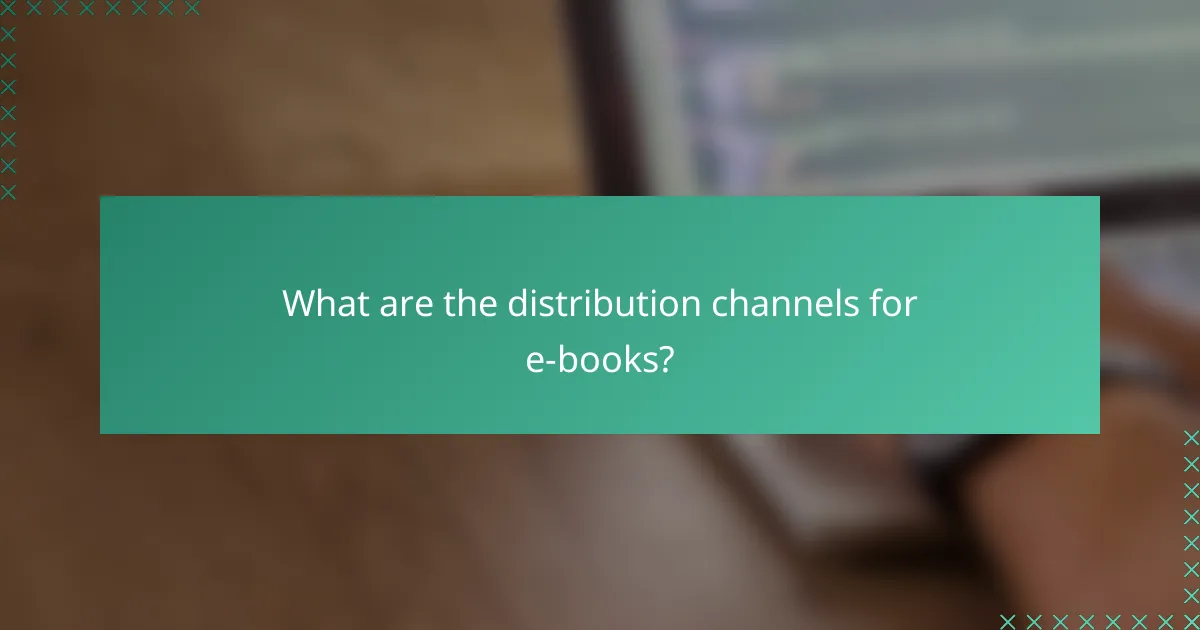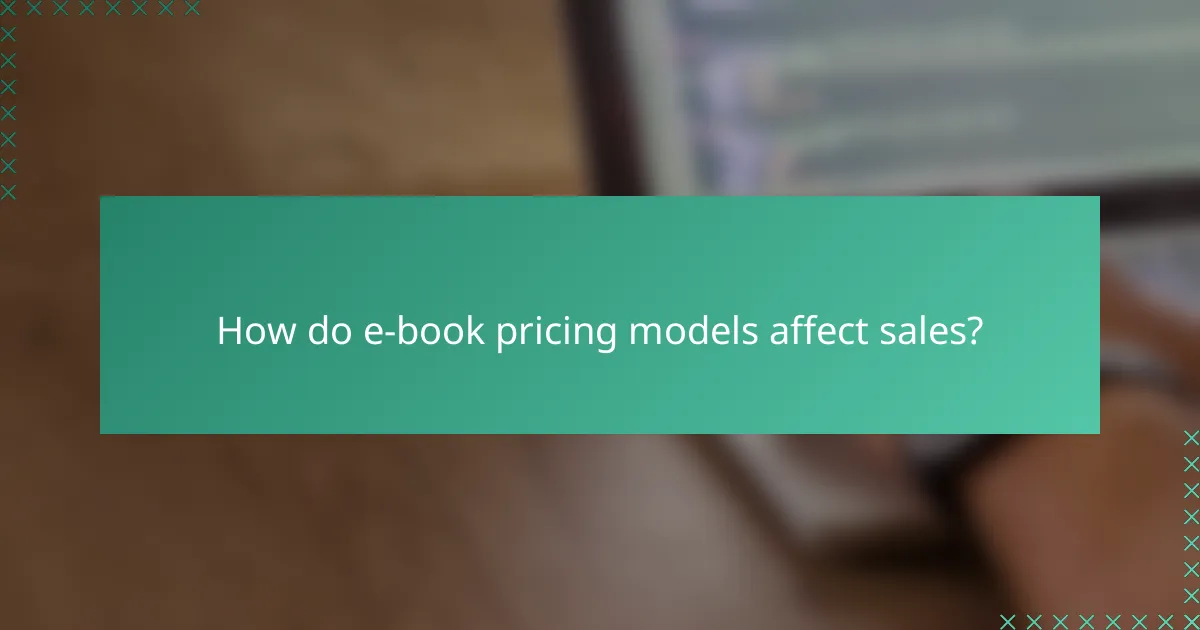E-books have transformed the publishing landscape, with various pricing models influencing how they are marketed and sold. Understanding the target audience, which ranges from students to casual readers, is essential for tailoring content and distribution strategies. Additionally, selecting the right distribution channels can significantly enhance an e-book’s visibility and sales potential.

What are the pricing models for e-books?
E-book pricing models determine how digital books are sold and can significantly affect sales and reader access. Common models include fixed, subscription, dynamic, freemium, and pay-per-download, each with unique advantages and considerations.
Fixed pricing model
The fixed pricing model sets a specific price for an e-book, which remains constant regardless of market conditions. This model is straightforward for consumers, allowing them to know exactly what they will pay, typically ranging from a few dollars to over twenty dollars, depending on the title and author.
Authors and publishers using this model benefit from predictable revenue and easier marketing strategies. However, they may miss opportunities for higher sales during promotional periods if they do not adjust prices accordingly.
Subscription pricing model
In the subscription pricing model, readers pay a recurring fee to access a library of e-books. This model has gained popularity with services like Kindle Unlimited and Scribd, where monthly fees can range from around $10 to $15.
This approach encourages readers to explore more titles without the commitment of individual purchases. However, authors may earn less per read compared to fixed pricing, as they typically receive a share of the subscription revenue based on the number of pages read.
Dynamic pricing model
The dynamic pricing model adjusts e-book prices based on various factors, such as demand, competition, or time since release. Prices may fluctuate, allowing publishers to capitalize on trends or seasonal sales, often ranging from discounted rates to premium pricing during high demand.
This model can maximize revenue but may confuse consumers who expect consistent pricing. Authors and publishers should monitor market trends and adjust prices strategically to optimize sales without alienating readers.
Freemium pricing model
The freemium pricing model offers a basic version of an e-book for free, with the option to purchase premium content or features. This approach can attract a large audience, allowing readers to sample the book before committing to a purchase.
While this model can effectively build a readership, it requires careful planning to ensure that the paid content provides sufficient value. Authors should consider what features or additional content will entice readers to upgrade.
Pay-per-download model
The pay-per-download model charges consumers for each individual e-book download, similar to traditional book sales. Prices can vary widely, typically from a few dollars to over thirty dollars, depending on the book’s popularity and content.
This model allows for straightforward transactions but may limit access for some readers. Authors should weigh the benefits of immediate revenue against the potential for broader reach through other pricing strategies.

Who is the target audience for e-books?
The target audience for e-books includes a diverse range of individuals, primarily students, professionals, casual readers, and self-publishers. Each group has unique needs and preferences that influence their engagement with e-books.
Students and educators
Students and educators are significant consumers of e-books, often seeking affordable and accessible learning materials. E-books provide interactive features like hyperlinks and multimedia, enhancing the educational experience.
Many educational institutions now incorporate e-books into their curricula, allowing students to access a wide array of resources without the burden of high textbook costs. This shift has made e-books a practical choice for both academic and personal study.
Professionals seeking skill development
Professionals looking to enhance their skills often turn to e-books for convenient and flexible learning. E-books can cover a vast range of topics, from technical skills to leadership strategies, catering to various industries.
Many professionals appreciate the ability to read e-books on multiple devices, allowing them to learn at their own pace. This flexibility is particularly valuable for busy individuals balancing work and personal commitments.
Casual readers
Casual readers enjoy e-books for their convenience and portability. With a wide selection available, readers can easily find genres that interest them, from fiction to non-fiction, without needing physical space for books.
Many e-book platforms offer subscription services, allowing casual readers to explore new titles at a low monthly cost. This model encourages exploration and discovery of new authors and genres.
Self-publishers and authors
Self-publishers and authors are increasingly using e-books as a primary means of distribution. The low cost of publishing and the ability to reach a global audience make e-books an attractive option for new writers.
Platforms like Amazon Kindle Direct Publishing allow authors to retain a significant portion of royalties, making e-books a financially viable choice. However, authors must also focus on marketing and visibility to stand out in a crowded marketplace.

What are the distribution channels for e-books?
Distribution channels for e-books are platforms or services through which authors and publishers can sell or distribute their digital books. Understanding these channels is crucial for maximizing reach and sales potential.
Amazon Kindle Direct Publishing
Amazon Kindle Direct Publishing (KDP) is one of the most popular platforms for e-book distribution. It allows authors to publish their books directly on Amazon, reaching millions of readers worldwide. KDP offers flexible royalty options, typically ranging from 35% to 70% depending on the pricing and distribution choices.
Authors should consider enrolling in KDP Select, which provides additional promotional opportunities but requires exclusivity to Amazon for a period. This can significantly boost visibility but may limit sales on other platforms.
Apple Books
Apple Books is a key distribution channel for e-books, particularly for authors targeting Apple device users. By publishing through Apple Books, authors can reach a large audience of iPhone and iPad users, benefiting from Apple’s ecosystem.
To publish on Apple Books, authors need to use the Apple Books for Authors platform, which allows for easy uploads and management of e-books. The royalty rate is typically around 70%, but authors should ensure their books meet Apple’s formatting and quality standards to avoid rejections.
Google Play Books
Google Play Books provides another significant avenue for e-book distribution, especially for Android users. Authors can publish their works directly on the Google Play Store, making them accessible to a vast audience.
Google Play offers a flexible pricing model and allows authors to set their own prices. However, authors should be aware of the platform’s policies regarding content and pricing, as well as the potential for promotional discounts to increase visibility.
Smashwords
Smashwords is an aggregator that distributes e-books to various retailers, including Barnes & Noble, Kobo, and Apple Books. This platform is ideal for authors looking to reach multiple markets without managing each retailer individually.
Authors can upload their e-books in various formats, and Smashwords takes care of the distribution. The royalty rates vary by retailer but generally fall within the 60% to 80% range, making it a cost-effective option for wider distribution.
Direct sales through author websites
Direct sales through an author’s website allow for maximum control over pricing and customer relationships. Authors can sell e-books directly to readers, keeping a larger share of the profits compared to third-party platforms.
To set up direct sales, authors need a website with e-commerce capabilities, such as WooCommerce or Shopify. This method requires more effort in marketing and customer service but can lead to higher profit margins and a loyal reader base.

What factors influence e-book pricing?
Several factors influence e-book pricing, including market demand, author reputation, genre, and the length and quality of the content. Understanding these elements can help authors and publishers set competitive prices while appealing to their target audience.
Market demand
Market demand plays a crucial role in determining e-book prices. When a particular genre or topic is trending, prices may rise due to increased interest. Conversely, if demand is low, prices might need to be adjusted downward to attract buyers.
Monitoring sales trends and reader preferences can provide insights into market demand. Tools like Amazon’s bestseller lists or reader reviews can help gauge what is currently popular.
Author reputation
The reputation of an author significantly affects e-book pricing. Established authors with a loyal following can often command higher prices compared to debut authors. Readers may be willing to pay a premium for works by well-known writers.
Building a strong author brand through social media engagement, consistent quality, and reader interaction can enhance reputation and justify higher pricing.
Genre and niche
Different genres and niches have varying pricing standards. For instance, romance and thriller e-books often sell at lower prices, typically ranging from $2.99 to $9.99, while specialized non-fiction or academic texts may be priced higher due to their targeted audience.
Understanding the pricing norms within a specific genre can help authors position their e-books appropriately. Researching competitors’ pricing can provide a useful benchmark.
Length and quality of content
The length and quality of an e-book also influence its price. Generally, longer e-books or those with high production values, such as professional editing and design, can be priced higher. A well-researched non-fiction book may justify a higher price than a short story.
Authors should consider the perceived value of their content. Offering a free sample or a lower introductory price can help attract initial readers and build momentum for future sales.

How do e-book pricing models affect sales?
E-book pricing models significantly influence sales by determining how much consumers are willing to pay and how accessible the books are. Different pricing strategies can attract various segments of the market, affecting overall revenue and readership.
Types of e-book pricing models
Common e-book pricing models include fixed pricing, dynamic pricing, and subscription-based pricing. Fixed pricing sets a specific price for each title, while dynamic pricing adjusts prices based on demand, competition, and other factors. Subscription models allow readers to access a library of titles for a monthly fee, appealing to avid readers.
For example, a fixed price might range from $2.99 to $9.99 for most genres, while subscription services like Kindle Unlimited charge around $9.99 per month for access to thousands of titles. Understanding these models helps publishers choose the best approach for their target audience.
Target audience considerations
Identifying the target audience is crucial for effective e-book pricing. Different demographics may have varying price sensitivities and preferences for how they consume content. For instance, younger readers may prefer subscription services, while older audiences might favor purchasing individual titles.
Market research can help determine the ideal pricing strategy. For example, romance and self-help genres often perform well with lower prices, while academic and specialized non-fiction may justify higher price points due to their niche appeal.
Distribution channels and their impact on pricing
Distribution channels play a vital role in e-book pricing models. Selling directly through an author’s website can allow for more flexible pricing and higher margins, while platforms like Amazon or Apple Books may impose pricing restrictions and take a percentage of sales.
Authors should consider the trade-offs of each channel. For instance, while Amazon offers vast reach, it might require pricing to be set at or below certain thresholds to remain competitive. Conversely, selling through personal channels can enhance profits but may limit visibility.
